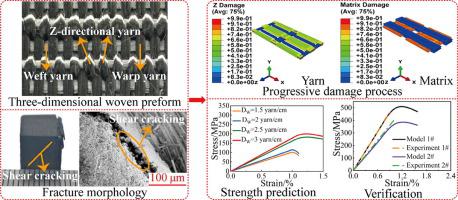Materials & Design ( IF 7.6 ) Pub Date : 2022-09-03 , DOI: 10.1016/j.matdes.2022.111108 Xue Yang , Jing Ai , Hao Zhu , Xiang-bin Du , Dian-sen Li , Lei Jiang , Dai-ning Fang

|
Three-dimensional orthogonal woven composites (3DOWCs) are extensively adopted in various civil and military fields. Parametric finite element models of 3DOWCs were established based on the mesoscale method to predict the compression strength and progressive damage process. The effects of structural parameters and loading directions on the failure mechanisms were investigated. The predicted results agreed well with the experimental data. The results revealed that yarn densities and loading directions significantly influenced the compression strength. It increased as yarn densities increased, and the weft compression strength was almost the largest in all directions and reached the maximum value of 634.8 MPa. In this case, it was 16.9% and 166.9% higher than that of the warp and Z-directions. Damage evolutions demonstrated that the damage of yarns and matrix occurred separately at the intersection of yarns and yarns, and yarns and matrix. The damage patterns of small warp and large weft yarn densities composites included yarn buckling, the interfacial debonding between yarns and matrix, and matrix cracking. Yarn kinking and fracture were the two main damage patterns of large warp and small weft yarn densities composites, while composites with large warp and large weft yarn densities were more prone to matrix cracking.
中文翻译:

3D正交编织复合材料的多向压缩行为和失效机制:参数化建模和强度预测
三维正交编织复合材料(3DOWCs)被广泛应用于各种民用和军用领域。基于中尺度方法建立了3DOWCs的参数化有限元模型,用于预测压缩强度和渐进损伤过程。研究了结构参数和加载方向对失效机制的影响。预测结果与实验数据吻合良好。结果表明,纱线密度和加载方向显着影响压缩强度。它随着纱线密度的增加而增加,纬向压缩强度几乎在所有方向上都最大,达到最大值634.8 MPa。在这种情况下,它比翘曲和 Z 方向高 16.9% 和 166.9%。损伤演化表明,纱线与基体的损伤分别发生在纱线与纱线、纱线与基体的交叉处。小经纱和大纬纱密度复合材料的损伤模式包括纱线屈曲、纱线与基体之间的界面脱粘和基体开裂。纱线扭结和断裂是大经纱和小纬纱密度复合材料的两种主要损伤模式,而大经纱和大纬纱密度的复合材料更容易发生基体开裂。











































 京公网安备 11010802027423号
京公网安备 11010802027423号